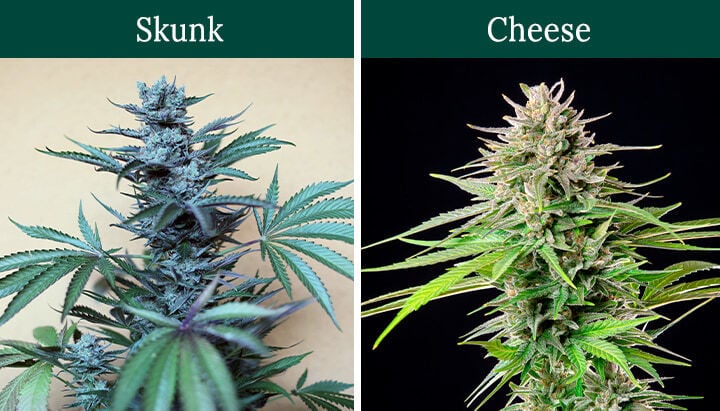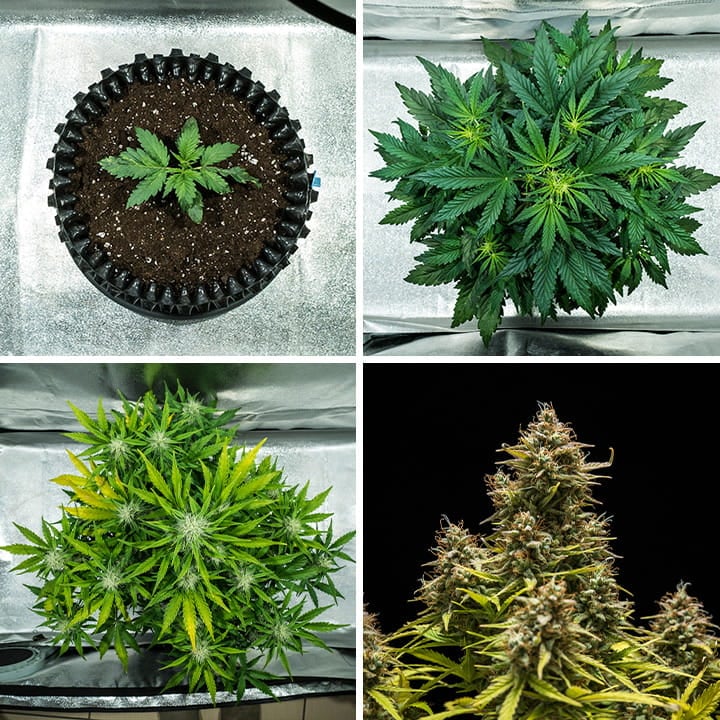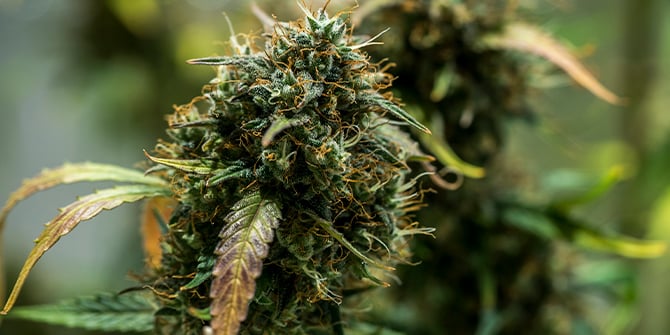The History of Cheese Marijuana Strains

Almost every cannabis smoker and grower is familiar with the Cheese strain. This titan has managed to stand the test of time, even in the contemporary era of ultra-potent cannabis genetics. In what follows, you'll learn everything you need to know about this legend and where she comes from. Then, you'll find out how to grow some of our finest Cheese varieties.
Contents:
What Is Cheese Cannabis?
The Cheese strain sits firmly on the pantheon of classic cannabis varieties. The cultivar has a complex origin story that starts in the United States and ends in the United Kingdom. While the modern era has brought about strains with record-breaking THC levels and alluring sugary terpene profiles, Cheese serves as a nostalgic reminder of times gone by.
Known worldwide for its distinct cheesy flavour and aroma, Cheese also serves up a stoning high that is physically relaxing without rendering users completely couch-bound. With its widespread adoption by growers and smokers alike, many breeders have used Cheese genetics as the foundation for new strains, all of which offer aromatic hints of their savoury predecessor.
Is Cheese the Same as Skunk?
Not quite. The Cheese strain and Skunk #1 have a lot in common, but they are two distinct strains. As you’ll discover in the history of Cheese further down the page, this variety first emerged as a phenotype of Skunk #1 following its introduction into the United Kingdom. Both Skunk #1 and Cheese share the same ancestry, but environmental factors that trigger permanent changes in gene expression ultimately led to the emergence of Cheese.
The strain differs from Skunk #1 in several ways, including its flavour profile, effects, and growing traits. Cheese started out as a clone-only variety, but breeders eventually began growing cuttings out to seed and stabilising the plants to mimic the aromatic profile of the original phenotype.


What Is the Story Behind the Cheese Strain?
The history of the Cheese weed strain starts in the United States in the 1980s. Here, legendary breeder Sam “the Skunkman” of Sacred Seeds decided to fill up a suitcase with his proprietary genetics and head to the emerging cannabis hub of Amsterdam. Among his stash of seeds, Sam transported his iconic creation Skunk #1. Here, the cultivar gained rapid popularity for its potent high and distinct aroma—made possible thanks to high levels of volatile sulphur compounds.
However, despite the alluring traits of this novel phenotype, growers in the country soon found themselves encountering trouble. While the pungency of these buds made Skunk #1 an instant hit, the aroma also gave the game away; many growers reported visits by the police as their plants entered the flowering stage. With this setback in mind, the popularity of Skunk #1 stood strong, but forced growers to innovate further and produce varieties with less-obvious odours. Growers in the UK caught wind of these genetics, and a special batch of seeds arrived there in the late 1980s.
Here, an unknown grower stumbled across a unique phenotype. Among its other traits, it possessed a particularly cheesy aroma not seen in regular Skunk #1 plants. To preserve the phenotype, the grower took a cutting that eventually ended up in the hands of The Exodus Collective. Known for their social activism and massive free parties, Cheese weed gained enormous popularity in the UK cannabis scene, and has remained at such heights ever since.
Is Cheese a Strong Strain?
The UK Cheese strain lacks the remarkable potency of many modern hybrids, yet many veteran cannabis smokers will tell you that this is no detriment to the Cheese experience.
The strain clocks in with a THC content of around 20%, but the cannabinoid doesn’t act in isolation to produce its effects. Other constituents, including terpenes, amplify the high and produce an uplifting and euphoric effect that is by no means insubstantial.
The Intense Aroma and Appeal of Cheese Weed Strains
The UK Cheese strain produces respectable yields and pleasant effects, but its aromatic profile truly sets it apart from the crowd, and is the main reason Cheese marijuana remains so popular to this day. An array of different terpenes contribute to its complex scent, including terpinolene, ocimene, and myrcene, which offer notes of mint, fruit, and herbs.
However, it's chiefly the volatile sulphur compounds (VSCs) within Cheese that underpin its unique scent and flavour. These pungent compounds are responsible for aromas of garlic, onion, cheese, and eggs. While this might sound off-putting on paper, these chemicals add a surprisingly tasty and savoury character to specific strains.
In Cheese buds, VSCs add potent notes of—you guessed it—cheese alongside hints of garlic. Meanwhile, the terpenes contribute subtle fruity and floral scents that round out the flavour profile nicely.
RQS Cheese Cannabis Strain Collection
Our skilled breeders at RQS have a penchant for Cheese weed strains. Over the years, they’ve leveraged the original cultivar, and her close ancestors, as breeding stock to create new Cheese cannabis varieties. By crossing her with an array of legendary genetics, they’ve managed to produce some of the tastiest and most productive cultivars available. Check out these strains below.
Royal Cheese
Royal Cheese stands as one of the stinkiest Cheese strains available. Start out by sowing your seeds directly into their final pots. Keep them well watered until sprouts emerge from the soil within 2–3 days. By the end of week 2, you’ll have yourself a robust and healthy seedling that stands at around 7cm tall, equipped with several small sets of true leaves. During week 4, your plant will have reached 26cm in height and possess large fan leaves and a thick, sturdy main stem.


We suggest making the transition into flowering during week 6. Your plant will have a dense and luscious canopy by this point. By week 9, you’ll have plenty of developing flowers and you’ll start to notice the pungent aroma of this strain filling up the growing space. As a fast-flowering variety, she will only take between 7–8 weeks to reach maturity! Come harvest time, you’ll pull in up to 550g/m² from indoor plants and up to 550g/plant from those grown outdoors.
Royal Cheese serves up a THC content of 19% alongside flavours of candy, cheese, and fruit. Enjoy a deeply stoning physical high every time you light up these buds.
Royal Cheese (Fast Flowering)
|
|
Old School Skunk x Afghani |
|
|
450 - 500 gr/m2 |
|
|
60 - 100 cm |
|
|
7 - 8 weeks |
|
|
THC: 17% |
|
|
Sativa 40% Indica 60% |
|
|
550 - 600 gr/plant |
|
|
130 - 200 cm |
|
|
Early October |
|
|
Balanced, Clear, Stoned |
Buy Royal Cheese (Fast Flowering)
Royal Cheese Auto
As the autoflowering version of Royal Cheese, Royal Cheese Auto delivers delicious buds in a fraction of the time. This speedy auto charges through the entire growing cycle in just 11–12 weeks after seeds sprout. Sow your seed directly into its final spot alongside a sprinkle of mycorrhizal fungi for optimal root system development. By the end of week 2, your seedling will stand at around 7–8cm. Maintain a humidity of around 60% at this stage. Apply low-stress training techniques during week 3, as your plant will start to display preflowers during week 4.


Switch over to bloom nutrients at the start of week 5 and consider applying some defoliation. Remove any leaves to allow good airflow and light exposure to any young bud sites inside the canopy. Begin a flush 2 weeks before you plan to harvest. Make sure you have enough stash jars to store up to 475g/m² indoors and 160–210g/plant outdoors.
Royal Cheese Auto pairs a THC content of 15% with scrumptious tastes of cheese, pepper, and skunk. She shares a similar flavour and effect to the original Cheese strain. Enjoy these buds in a dry herb vape to get a true appreciation for their flavour, and enjoy a lightly stoning experience.
Royal Cheese Auto
|
|
Cheese x Royal Critical x Ruderalis |
|
|
425 - 475 gr/m2 |
|
|
60 - 100 cm |
|
|
7 - 8 weeks |
|
|
THC: 15% |
|
|
Sativa 30% Indica 50% Ruderalis 20% |
|
|
160 - 210 gr/plant |
|
|
60 - 120 cm |
|
|
11 - 12 weeks after sprouting |
|
|
Physically Relaxing, Stoned |
Blue Cheese
Prepare to have your taste buds activated by Blue Cheese. As the progeny of Original Cheese and Oregon Blueberry Blend, you’ll encounter exceptional levels of VSCs and fruity terps in these buds. Prepare a grow space that can handle plants that peak at 160cm indoors and 200cm outdoors. Pop seeds using the glass of water method and transfer sprouts into their final pots once their taproots reach a length of 2cm. Start running your lights indoors as soon as sprouts emerge. By week 3, your plant will have already grown to 50cm. Make the decision at this point to apply training to keep your plants from exceeding 100cm, or leave them untrained to peak at their max height indoors.


Make the switch to bloom around week 6–7. You’ll notice a weak smell start to emerge a week later. At weeks 9–10, start to deploy odour-control strategies. At this point, you’ll notice her buds begin to swell. Wait for the majority of her pistils to turn orange before harvesting at around weeks 13–14. You’ll pull in up to 550g/m² from indoor specimens.
Enjoy a relaxing and stoning high fuelled by a THC content of 19%. A medium CBD level helps to keep things mellow. Tastes of candy, cheese, and fruit will lead you back to this strain again and again.
Blue Cheese
|
|
Original Cheese x Oregon Blueberry Blend |
|
|
500 - 550 gr/m2 |
|
|
100 - 160 cm |
|
|
8 - 9 weeks |
|
|
THC: 19% |
|
|
Sativa 40% Indica 60% |
|
|
500 - 550 gr/plant |
|
|
140 - 200 cm |
|
|
Late September |
|
|
Clear, Physically Relaxing, Stoned |
Blue Cheese Auto
If you’d rather taste what Blue Cheese has to offer in a shorter period of time, then you need to get your hands on Blue Cheese Auto seeds. This descendent of Blueberry, the original Cheese strain, and ruderalis genetics offers beautiful purple-green buds and delightful cheesy flavours. You’ll have a seedling that stands around 2cm tall within one week of germination. This strain responds well to liquid seaweed, fish emulsion, and worm tea during the vegetative phase. Employ your preferred training techniques around week 3 of veg to keep your plants as compact as 40–60cm throughout the entire growing cycle. By week 4, your plant will boast a thick and robust stem and large, waxy fan leaves, as well as emerging preflowers.


Switch over to bat guano and fermented fruit juice during bloom to cater to increased phosphorus demands. You’ll notice a powerful cheesy aroma fill up your growing space by week 8. Carbon scrubbers work well to contain the stench indoors, whereas companion plants such as mint and basil do a good job when it comes to odour control outdoors. Prepare to harvest up to 375g/m² indoors and 60–110g/plant outdoors.
Then, get ready to blast your taste buds with flavours of cheese, earth, fruit, and pepper. As these flavours fade, you’ll feel an uplifting high start to take hold.
Blue Cheese Auto
|
|
Blueberry x Cheese x Ruderalis |
|
|
325 - 375 gr/m2 |
|
|
40 - 70 cm |
|
|
6 - 7 weeks |
|
|
THC: 16% |
|
|
Sativa 35% Indica 40% Ruderalis 25% |
|
|
60 - 110 gr/plant |
|
|
60 - 110 cm |
|
|
10 – 11 weeks after sprouting |
|
|
Clear, Uplifting |
Fast Eddy Automatic CBD
If you’re seeking a fast-growing strain that offers savoury flavours, then let us introduce you to Fast Eddy Automatic CBD. This high-CBD strain descends from Cheese, Juanita la Lagrimosa, and ruderalis genetics. Once you pop your seeds, get ready to watch this strain race through the entire growing cycle in just 10–12 weeks. You’ll have yourself a 5cm seedling at the end of week 1 of veg. Maintain humidity levels of around 70% to spur healthy growth. This Cheese weed plant will reach 18cm at around week 3; tie down the growing tip to send lateral branches skyward to form a flat and productive canopy. The emergence of preflowers during week 4 will mark the transition to bloom.


When the second week of flowering swings around, you’ll already notice young buds packed with white pistils. An unmistakable aroma of cheese will start to flood your growing space during week 3 of bloom. Flush your plants 2 weeks before harvest to end up with the smoothest buds possible. Prepare your drying space to house up to 450g/m² from indoor plants and 80–130g/plant from their outdoor counterparts.
Fast Eddy Automatic’s THC and CBD content of 9% each will leave you clear-headed and feeling as though you’re floating on a cloud. Savour scrumptious tastes of cheese, citrus, and earthiness.
Fast Eddy Automatic CBD
|
|
Cheese x Juanita la Lagrimosa x Ruderalis |
|
|
400 - 450 gr/m2 |
|
|
60 - 100 cm |
|
|
7 - 8 weeks |
|
|
THC: 9% |
|
|
Sativa 50% Indica 40% Ruderalis 10% |
|
|
80 - 130 gr/plant |
|
|
80 - 120 cm |
|
|
10 - 12 weeks after sprouting |
|
|
Calming, Clear |
Categories
Strain Families







































